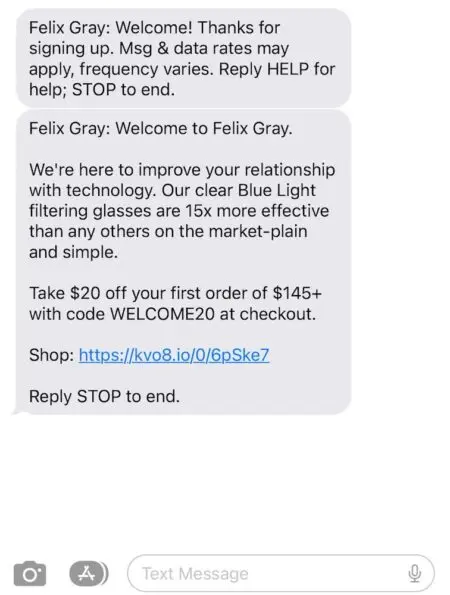What is omnichannel marketing? Here’s why it’s better than multi-channel (and how to get it right)
Omnichannel marketing reflects the true nature of a customer journey: messy, non-linear, and difficult to track.
According to Forbes, it takes, on average, 6 separate touchpoints for a consumer to purchase a product. Omnichannel marketing, in response, focuses on creating a consistent experience for customers across multiple offline and online channels.
When customer touchpoints—across websites, mobile apps, social media, email, and physical stores—are one long conversation as opposed to several fragmented ones, it’s instantly easier for your brand to serve people with a consistent narrative and an exceptional purchase experience.
While not many brands are executing omnichannel marketing to its full potential, most understand the need to provide customers with a seamless experience. In 2021, 67% of ecommerce companies said an omnichannel approach was important to them. But in 2022, only 35% of marketers said they were “successfully achieving omnichannel personalisation.”
Here, we’ll walk you through the difference between omnichannel and multi-channel strategies, omnichannel marketing best practices, and a solid example of one long, realistic customer journey that ends in a sale.
Omnichannel vs. multi-channel: what’s the difference?
The main difference between an omnichannel and multi-channel approach is the integration of data.
Omnichannel marketing requires a centralised customer profile that calibrates a better customer experience across whatever marketing and sales channels the customer chooses. This customer profile, within the customer data platform, is what makes it possible for someone to click on a Facebook ad, place an item in their cart, abandon that cart, and then complete a purchase after getting an email with a discount code for the product they abandoned.
Multi-channel marketing isn’t quite as sophisticated. In multi-channel marketing, brands can still create consistent touchpoints through copywriting and design—but they’re not personalised to the customer because data isn’t shared across channels. If your customer taps on an Instagram ad but doesn’t purchase, your customer service team has no idea that interaction occurred.
| Omnichannel marketing | Multi-channel marketing | |
| Customer data | Shared across multiple channels | Siloed in each marketing channel |
| Brand experience | One consistent conversation across all brand channels | Separate conversations with the same customer |
| Purchase opportunities | Customer can purchase via each channel | Customer may only purchase on some channels |
| Personalisation mechanism | Every marketing channel contains the same data on the customer | Every channel contains some or no information about the customer |
| Tech requirements | Requires a customer data platform (CDP) with other app integrations | Lower tech requirements, dependent on channels chosen by brand/customers |
| Revenue attribution | Holistic, considering all channels before sale and last touchpoint | Attributes sale to final touchpoint only, which offers only partial view |
What a realistic omnichannel customer journey looks like
Omnichannel marketing strategies rise to the occasion of the complex buyer’s journey. As much as marketers love to believe customers purchase products after seeing a few ads and subscribing to an email list for a discount, the reality is much more chaotic.

Here’s what a buyer’s journey might look like at Felix Gray, a glassware brand that’s embraced an omnichannel marketing strategy:
1. Casey’s pup recently chomped her reading glasses, and she’s in need of a new pair. She Googles “Felix Gray glasses” after asking a friend at work where she got hers.
2. Casey browses the Felix Gray website and filters by lens type, but she doesn’t find anything that catches her eye. She’s also on a work break and doesn’t have time to commit to a purchase.
3. A week later, Casey sees an ad on Instagram for “glasses that work as hard as you do.” She doesn’t like the color of the glasses in the image and doesn’t click on the ad.

4. Casey bumps into her colleague at the gym. They don’t talk about Felix Gray at all. But Casey is reminded of the glasses she liked when she sees her colleague wearing a similar pair, so she pulls the oldest trick in the book: She signs up for Felix Gray’s email marketing and SMS marketing and waits for an offer to hit her inbox.

5. Casey receives an offer right away, but she’s still feeling indecisive. She clicks through to the website, finds a frame shape and color she likes, and puts the glasses in her cart. But then she has second thoughts. Should she really be buying a pair of glasses she hasn’t tried on, even if she has $20 off?
6. An hour after Casey abandons her cart, Felix Gray sends Casey an abandoned cart email with a discount, but she ignores it—10% off a pair of glasses that cost $145 isn’t enough to convince her to buy online. She considers dropping by the retail store, but it’s not in her neighborhood. Maybe she’ll get a pair from her local vendor.
7. A few days later, Casey receives a direct mail booklet from Felix Gray that highlights the benefits of their blue-light-filtering technology and mentions their contact lenses. She’s intrigued and decides a trip to the store will be worth her while.

8. Casey’s personal shopping experience at Felix Gray is thoroughly enjoyable, and she buys a pair of glasses. Her personal shopper also helps her sign up for a contact lens subscription.
9. Casey gets an email just before the holidays that Felix Gray is running a special discount for Black Friday Cyber Monday. She finds it’s the perfect opportunity to purchase that pair of sunglasses she’s had her eye on.

5 tips for building your omnichannel marketing strategy
We won’t lie to you—building an omnichannel marketing strategy isn’t easy. But it sure is satisfying.
The industry’s best marketers understand that marketing can’t succeed within its own silo. Successful marketing teams align with customer service, product, IT, and others to create a cohesive brand experience. Nothing tests this kind of collaboration more than omnichannel marketing.
We asked marketing experts about some of their biggest challenges in implementing an omnichannel marketing strategy. Here’s what they mentioned:
1. Invest more in internal alignment than you think you need to
For starters, “omnichannel marketing” may be a misnomer. An omnichannel approach requires a lot more than marketing to pull off.
Jessica Totillo Coster, ecommerce and email marketing strategist at eCommerce Badassery, says the biggest challenge she sees with brands that want to launch an omnichannel integrated marketing campaign is “a lack of organisation and processes.”
Often departments are siloed, and there isn’t an overarching person to bring it all together. Sometimes each department’s agenda gets in the way of the big-picture goal for the company or campaign.
“Often departments are siloed, and there isn’t an overarching person to bring it all together,” Coster explains. “There isn’t enough inter-department communication. Sometimes each department’s agenda gets in the way of the big-picture goal for the company or campaign.”
Consider the Felix Gray example above, where many teams were responsible for the touchpoints that led to a sale:
- Technology and product teams worked together to create website filters relevant to customers’ preferences.
- The customer service team was responsible for the personal shopping experience that attracted the customer to the store and finalised the sale.
- The marketing team analysed customer interactions and delivered personalised offers through thoughtful copy and design.
Before you begin to sketch out your omnichannel marketing strategy:
- Schedule conversations with key members from other teams.
- Ask questions about how each department interacts with customers.
- Use each person’s responses as a basis for your customer journey audit (more on this next).
2. Use customer data to understand your buyer’s journey
While everyone contributes to an omnichannel strategy, it is the marketing team’s responsibility to understand the customer journey inside and out.
Your conversations with key team members and (hopefully) customers will give you the qualitative data you need to map your customer journey—but you’ll also need some quantitative data to complete the picture.
For example, you’ll learn a lot from your customer service team about what your customers want—but you won’t be able to learn whether your abandoned cart email series is actually leading to significant sales.
Use first- and zero-party data to map your customer journey. You’ll need to look at data points like:
- Lifetime purchase history and predicted customer lifetime value (CLV)
- Email, SMS, and mobile push subscribe and engagement rates
- Website and in-store activity, and sources of that activity
- User location
- Product preferences
- Enrolment in customer loyalty programs, and specified tiers
- Birthday and anniversary of first purchase
- Product reviews and other user-generated content (UGC)
- Other data collected through surveys or quizzes
Depending on your tech stack, you may be limited in the kind of data you can access to learn about your customer journey. This is why new marketing automation technology is crucial for an omnichannel strategy that reflects your customer’s real, non-linear path to a sale.
3. Make sure your tech can deliver omnichannel experiences
Many enterprise brands say it’s important to centralise customer data in a CDP. But their tech stacks aren’t built for omnichannel experiences.
Many brands are still operating on outdated tech stacks that don’t have the functionality to stitch together all their customer information—which is crucial for an omnichannel user experience.
In a 2022 survey, ecommerce executives said they would need the following from their tech stacks in order to create an omnichannel customer experience:
- Clean data on customer behaviour
- Real-time, cross-device data from their API
- Transaction data captured on site
- Synced data across content and commerce channels
- Unified customer profiles
The right CDP can support your omnichannel marketing strategy and make sure all your tech speaks the same language.
4. Use segmentation to create personalised experiences that boost customer retention
Once you have the technology you need for unified customer profiles, what do you do with the data?
Personalised omnichannel experiences rely on segmentation—the process of categorising and then communicating with your customers based on observable behaviours and preferences that help you anticipate what will make each segment most likely to buy from you.
Your customer segments will look different from another company’s, but here are a few examples and their corresponding experiences:
- VIP customers → Early access to promotions or new product launches
- SMS opt-ins → Location-specific event/pop-up announcements
- Cart abandonment → Custom product guide based on what they viewed
5. Commit to A/B testing
As you begin to run your omnichannel marketing strategy, some experiences will resonate with customers more than others. To maximise your chance at success, find out if strategies are worth continuing, and protect your business against colossal failure, A/B test new experiences.
A simple example of an A/B test is the way you build your email list. It’s common knowledge that most online stores build their email lists by offering a discount in exchange for subscribing. But do you really need to exchange a discount for a subscription?
Brava Fabrics was curious about exactly that question—so they came up with an alternative. They tested a 10% discount against a contest that entered people to win €300 in free products for signing up.
Turns out, the two options performed identically, so they went with the more budget-friendly contest option. Giving only one customer a prize rather than a universal discount helped Brava Fabrics protect their marketing budget—and was one of many smart strategies that drove a 76% YoY increase in email revenue.
Omnichannel marketing FAQs
How is omnichannel marketing different from single-channel marketing?
Omnichannel marketing allows businesses to reach customers via multiple different channels, while single-channel marketing targets customers using only one communication channel (like only email or SMS). Whether omnichannel is better depends on various factors, including business goals, target audience, and resources available. If the customer journey involves multiple touchpoints, an omnichannel approach can allow businesses to engage customers at different stages and provide consistent messaging and experiences.
How can businesses improve customer support with omnichannel marketing?
Businesses can improve customer support with their omnichannel marketing strategy by:
1. Centralising customer data to gain a complete view of customer relationships
2. Offering new customers self-service options like mobile apps, chatbots, or knowledge bases for quick issue resolution
3. Training agents to provide personalised assistance
4. Monitoring customer feedback to identify areas of improvement
5. Using marketing automation and AI tools to handle routine inquiries and improve response times
How can businesses integrate online and offline channels in an omnichannel marketing strategy?
To integrate online and offline channels in an omnichannel marketing strategy, businesses should focus on:
1. Creating a cohesive brand experience
2. Collecting and sharing customer data
3. Enabling cross-channel communication
4. Leveraging digital tools in physical brick-and-mortar stores
5. Offering buy online, pick up in store or ship-from-store options
6. Bridging online and offline promotions
7. Providing personalised experiences



